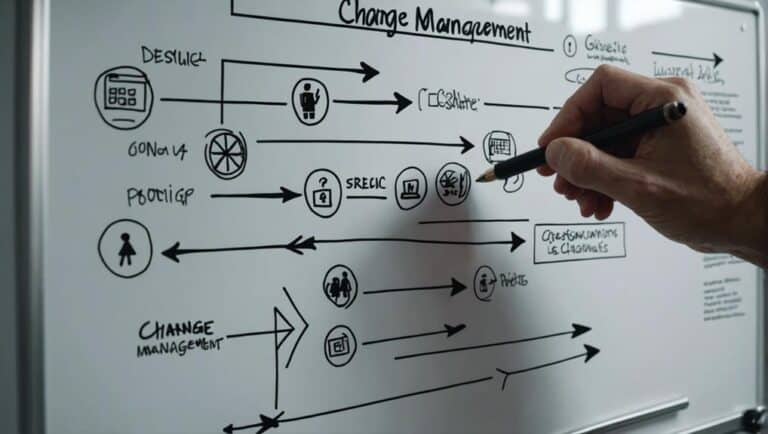Imagine change management as the compass guiding a ship through stormy waters; it steers the course to avoid risks and reach the intended destination. However, simply knowing the direction isn't enough; understanding how to navigate the turbulent seas of risk is paramount.
By exploring the interplay between change and risk management, you can uncover strategies to not just weather the storm but also harness its power for organizational growth. Stay tuned to discover how integrating change and risk management can transform challenges into opportunities for success in today's dynamic business landscape.
Key Takeaways
- Integrating change and risk management is essential for navigating uncertainties and capitalizing on opportunities.
- Identifying and analyzing risks in change initiatives helps in proactively addressing potential risks.
- Utilize risk identification and mitigation methods to prioritize risks and develop appropriate response strategies.
- Achieve resilience in change management by addressing concerns, involving stakeholders, and integrating risk management for successful initiatives.
Importance of Integrating Change and Risk Management
Integrating change and risk management is crucial for organizations aiming to navigate uncertainties and capitalize on opportunities effectively. By implementing a robust change risk management framework, organizations can proactively address potential risks that may arise during periods of change. This framework involves conducting thorough risk analysis to identify, assess, and mitigate risks that could hinder the success of change initiatives.
Effective management of change and risk aligns organizational strategies with risk mitigation efforts, ensuring that the organization can achieve its objectives despite potential disruptions. It enables informed decision-making and resource optimization, enhancing the organization's ability to adapt to changing circumstances.
Furthermore, the integration of change and risk management processes cultivates a culture of continuous improvement and proactive risk identification within the organization. By fostering this culture, organizations can better anticipate and respond to challenges, ultimately increasing their resilience and ability to thrive in dynamic environments.
Identifying Potential Risks in Change Initiatives
When identifying potential risks in change initiatives, start by reviewing critical success factors and conducting stakeholder interviews for valuable insights.
Utilize a risk assessment matrix to prioritize risks based on their likelihood and impact on the change management process.
Implement mitigation strategies to address identified risks effectively and minimize their adverse effects on the change initiative.
Risk Identification Methods
To identify potential risks in change initiatives, various techniques such as brainstorming, interviews, surveys, checklists, and SWOT analysis are utilized to gather vital information from stakeholders, experts, and data. These methods assist in generating a comprehensive list of potential risks by considering interrelationships, dependencies, likelihood, and impact of each risk on change initiatives. Internal and external risks that may positively or negatively impact change are assessed, prioritized based on severity and urgency, and analyzed using tools like risk matrices, registers, or maps. The probability and impact of each risk are evaluated to develop appropriate risk response strategies such as avoidance, mitigation, transfer, or acceptance to address risks effectively. Assumptions, uncertainties, and feedback are considered in risk analysis to continuously monitor, review, and adjust risk response plans for successful change management.
| Risk Identification Methods | |
|---|---|
| Brainstorming | Interviews |
| Surveys | Checklists |
| SWOT Analysis |
Mitigating Change Risks
Mitigating potential risks in change initiatives involves a thorough analysis of internal and external factors that could impact the successful implementation of the desired changes. When managing risks, change requires a meticulous process of identifying potential obstacles and developing strategies to address them effectively. Here are key points to consider in mitigating change risks:
- Analyze internal and external factors impacting the change process.
- Identify potential risks such as resistance to change, lack of stakeholder buy-in, and inadequate resources.
- Prioritize risks based on likelihood and impact on change objectives.
- Develop proactive mitigation strategies to address potential challenges.
- Increase the likelihood of successful implementation by understanding and addressing potential risks comprehensively.
Analyzing Risks for Effective Mitigation
Analyzing risks plays a crucial role in developing effective mitigation strategies for successful change management. Risk analysis involves evaluating the likelihood and impact of each identified risk in the change management process.
By prioritizing risks based on severity and urgency, you can direct attention towards critical areas needing mitigation strategies. Tools such as risk matrices, registers, or maps can assist in visualizing and managing identified risks efficiently.
Effective risk mitigation strategies seek to minimize negative impacts and maximize positive outcomes during change management. It's essential to continuously monitor and adjust risk response plans to proactively manage risks throughout the change process.
Through thorough risk analysis, you can better understand potential obstacles, enabling you to tailor mitigation strategies effectively. Remember, a proactive approach to risk analysis is key to successful change management.
Strategies for Responding to Risks Proactively
Proactively addressing risks requires a comprehensive understanding of potential vulnerabilities and strategic responses to ensure successful change management. To effectively respond to risks in a proactive manner, consider the following strategies:
- Utilize Proactive Risk Response Strategies: Implement avoidance, mitigation, transfer, and acceptance techniques to address potential risks effectively.
- Communicate Risk Response Plans: Ensure alignment and transparency by sharing the risk response plan with stakeholders to facilitate managing change-related risks.
- Engage in Continuous Monitoring: Regularly review and adjust risk response plans to adapt to emerging risks and ensure effectiveness in managing change.
- Utilize Risk Management Tools: Prioritize risks based on severity and urgency using tools like risk matrices, registers, and maps for timely intervention.
- Enhance Risk Management Processes: Foster a culture of proactive risk identification and management by adjusting risk management processes based on monitoring outcomes to support successful change initiatives.
Enhancing Organizational Preparedness and Adaptability
To enhance organizational preparedness and adaptability, it is imperative to conduct a thorough assessment of potential risks and develop robust strategies for effective management. Managing change risks successfully involves proactive planning, communication, and alignment with organizational goals. By fostering a culture of continuous improvement and learning from experiences, organizations can enhance their preparedness for unforeseen challenges. Adaptability in change management is crucial for thriving in dynamic environments, allowing for adjustments to strategies in response to changing circumstances. Integrating risk management into change initiatives ensures that organizations are equipped to navigate uncertainties and seize opportunities for successful change.
| Risks | Manage Change Risk | Successful Change |
|---|---|---|
| Assess potential risks | Develop proactive strategies | Align with organizational goals |
| Foster continuous improvement | Adapt strategies as needed | Communicate effectively |
| Build resilience | Respond to changing circumstances | Thrive in dynamic environments |
Implementing Change Management Best Practices
To effectively implement change management best practices, you must focus on key steps that align organizational objectives with risk management strategies.
Overcoming resistance plays a crucial role in ensuring successful change initiatives.
Utilizing tools like risk matrices and involving stakeholders in decision-making are essential components for mitigating risks during change processes.
Key Steps for Implementation
Implementing change management best practices requires a meticulous assessment of risks associated with change initiatives, emphasizing critical success factors and stakeholder insights. To ensure successful change outcomes, consider the following key steps:
- Utilize a risk assessment matrix to prioritize risks and implement effective mitigation strategies.
- Integrate change risk analysis into an ERM strategy using tools like ZenGRC for enhanced success.
- Align the Head, Heart, and Guts of the organization to drive willingness to change and execution capabilities.
- Develop capabilities in the Guts, Heart, and Head of the organization for effective change risk management.
- Foster a culture that embraces change by nurturing a proactive approach to risk management.
Overcoming Resistance Effectively
Addressing concerns, fears, and uncertainties among stakeholders is crucial for effectively overcoming resistance in change management. Senior management plays a vital role in acknowledging and addressing these concerns to alleviate resistance to change.
Resistance to change often stems from various factors, including fear of the unknown, loss of control, or change fatigue. To combat this, senior management must communicate openly, engage with employees, and involve them in the change process. Providing the necessary resources, training, and support can help individuals navigate through the transition more smoothly.
Achieving Resilience Through Risk-Aware Change Management
Achieving resilience through risk-aware change management entails embedding effective risk mitigation strategies within change processes to proactively anticipate and address uncertainties. By incorporating risk management into managing change, firms can enhance their resilience by aligning initiatives with organizational goals and identifying potential risks early on.
This strategic approach not only promotes adaptability but also enables organizations to respond promptly to emerging risks and opportunities. Effective risk-aware change management ensures that the benefits of change outweigh the costs, ultimately leading to successful implementation and sustainable outcomes.
Moreover, by integrating risk management practices into change initiatives, organizations cultivate a culture of proactive risk identification and management, fostering resilience and adaptability.
- Embedding risk mitigation strategies in change processes
- Aligning change initiatives with organizational goals
- Enhancing organizational agility through proactive risk identification
- Ensuring that benefits of change exceed costs
- Building a culture of proactive risk management for resilience
Frequently Asked Questions
How Do You Manage Risks Associated With Change?
When managing risks associated with change, you must conduct thorough risk assessment to understand potential impacts. Identify key areas for change impact, develop a mitigation plan to address these risks effectively, and ensure alignment with organizational goals for successful outcomes.
What Are the 5 R's of Change Management?
You manage change through the 5 R's: resist, recognize, react, realize, reinforce. Address resistance, gain stakeholder buy-in, and ensure new behaviors stick. Communication dynamics, stakeholder engagement, and team resilience are key for successful change initiatives.
What Are the Five 5 Change Management Strategies?
You communicate with clarity, engage stakeholders effectively, and implement a robust training program. These strategies drive successful change initiatives, aligning teams and fostering a culture of adaptability, resilience, and innovation in your organization.
What Are the 7 R's of Change Management?
When managing change, focus on the 7 R's: reasons, return, risks, resources, responsible, rewards, and resistance. Engage stakeholders, plan communication, address resistance, develop training, assess impact, and ensure readiness. Strategic attention to these areas leads to successful change implementation.
Conclusion
As you navigate the turbulent waters of organizational change, remember that risk management is your compass, guiding you through uncertain seas.
By integrating change and risk management, you can steer your ship towards success, avoiding potential obstacles and charting a course towards resilience.
Embrace the challenges as opportunities for growth, and with proactive strategies, you can weather any storm that comes your way.
Stay vigilant, stay adaptable, and let risk-aware change management be your guiding star.





